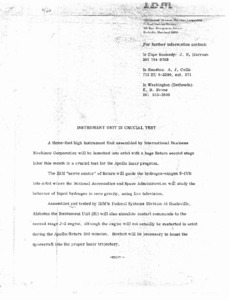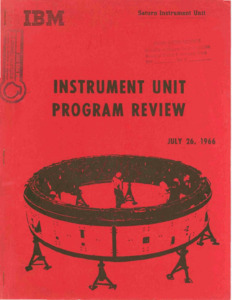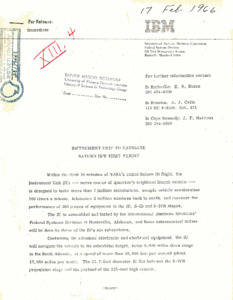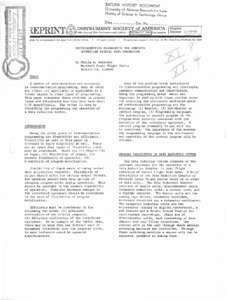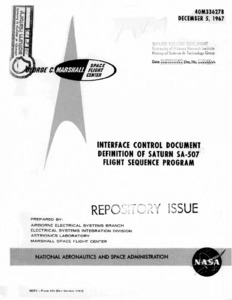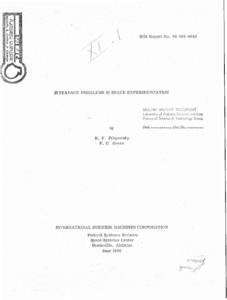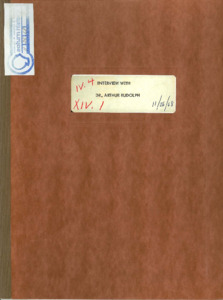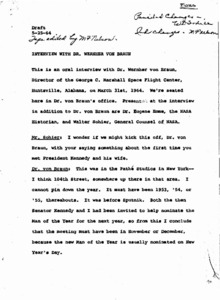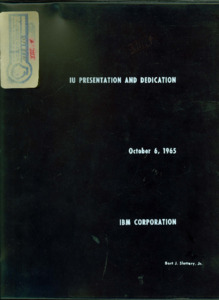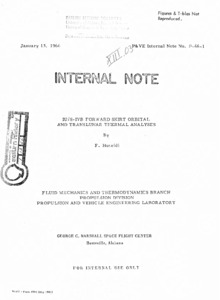
Browse Items (1976 total)
Sort by:
-
"Instrument Unit in Crucial Test."
A three-foot high Instrument tional Business Machines Corporation will be launched into orbit with a huge Saturn second stage
later this month in a crucial test for the Apollo lunar program. -
"Instrument Unit Program Review : Saturn Instrument Unit."
Handwritten names and phone numbers on the first page. Apollo / Saturn Team. -
"Instrument Unit to Navigate Saturn IB's First Flight.".
Within the first 10 minutes of NASA's initial Saturn IB flight, the Instrument Unit (IU), nervecenter of America's mightiest launch vehicle, is designed to make more than 7 million calculations, sample vehicle calculations 100 times a minute, telemeter 3 million numbers back to Earth, and measure the performance of 300 pieces of equipment in the IU, S-IB, and S-IVB stages. -
"Instrumentation Programming for Computer Controlled Digital Data Processing."
A number of considerations are necessary in instrumentation programming, many of which are either not applicable or applicable to a lesser degree in other types of programming. This paper discusses these problems in general terms and illustrates how they have been dealt with specifically. The latter is done by describing the programming and operation of a data reduction system. -
"Interface Control Document Definition of Saturn SA-507 Flight Sequence Program."
The purpose of this document is to define the flight sequence events, time bases, stage switch selector channel assignments, LVDA Discrete Outputs, Inputs and Interrupts for the Saturn SA-507 & Subs vehicles. Special requirements and restrictions defined in this document will be imposed on the Marshall Space Flight Center and its contractors as applicable, to insure the proper functioning of the equipment in the various stages for required vehicle timing and sequencing to occur as outlined in this Interface Control Document (ICD). -
"Interface Problems in Space Experimentation."
Space experimentation is expanding rapidly. Unmanned satellites are being equipped with precision instruments of greater power, and manned space stations accommodating large crews are in the drawing-board stage. The interface problems between these sophisticated instruments and between man, the spacecraft, and the supporting groundstations are multidimensional. This paper analyzes the scientific/technical areas of space experimentation, and continues with a review of the subsystems and support systems required to supply and operate the large variety of instruments. Areas of major integration efforts are singled out and the requirements for further developments and improvements are listed. A bibliography of 95 references is enclosed to assist in the identification of more detailed reports on all vital aspects of space experimentation.; Archive copy is a photocopy.; Supplement to IEEE Transactions on Aerospace and Electronic Systems, Vol. AES-2, No. 4, July, 1966. Pages 237 to 255. -
"Interview With Dr. Arthur Rudolph."
Transcription of an interview between Davis S. Akens and Arthur Rudolph -
"Interview with Dr. Wernher von Braun."
Transcription of an interview with Wernher von Braun and Mr. Sohier. -
"IU Presentation and Dedication."
This is a note book that contains newspaper articles and photographs about the new IBM building in Huntsville, Alabama. It also has information about the Instrument Unit for the first Saturn IB flight. There is also information about the Saturn IB Instrument Unit being barged to Kennedy Space Center.; There are 2 pages that list the articles with the title, newspaper name, writer and date.; There are six color photographs that show the dedication of the IBM building and the Instrument Unit. One photograph has Dr. Wernher von Braun standing behind the ring. Two of the photographs show the Instrument Unit on a trailer being pulled by a truck.; Preferred Citation: [Identification of item] Saturn V Collection, Dept. of Archives/Special Collections, M. Louis Salmon Library, University of Alabama in Huntsville, Huntsville, AL. -
"IU/S-IVB Forward Skirt Orbital and Translunar Thermal Analyses."
This report determines the maximum and minimum solar and terrestrial thermal energy incident and absorbed by Saturn IB/V vehicles in earth orbit and translunar travel. The influence' of this external energy on the Instrument Unit Thermal Conditioning System performance, and consequently its adequacy to maintain the electronic packages at acceptable temperature limits is ascertained. Conclusions are: a) Methanol/water coolant temperature will deviate from 111 specifications only during translunar cold flights. However, adequate thermal conditioning of the electronic equipment would still be maintained. b) Instrument Unit missions exceeding 6 1/2 hours, or electronic packages heat dissipation magnitudes lower than 3 kw or higher than 8.5 kw, should be reviewed to ascertain thermal compatibility.
